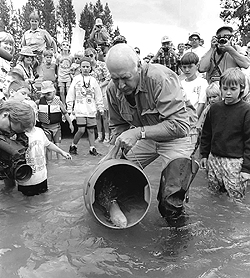forum
library
tutorial
contact

Cecil Andrus was an Important
and Influential Salmon Advocate
by Greg Stahl
Idaho Rivers United Blog, September 1, 2017
|
the film forum library tutorial contact |

|
Cecil Andrus was an Important
by Greg Stahl
|
 Idaho said goodbye to an Idaho icon this week, a man whose work to protect clean water, open spaces and wild creatures made a tangible difference for Idaho and the nation.
Idaho said goodbye to an Idaho icon this week, a man whose work to protect clean water, open spaces and wild creatures made a tangible difference for Idaho and the nation.
Gov. Cecil Andrus died Thursday, Aug. 24, due to complications from lung cancer. He was a four-time governor and secretary of the interior during the President Jimmy Carter administration. He was laid to rest Aug. 31 in Boise.
Here at home Andrus will be remembered for saving Castle Peak in the White Cloud Mountains from a strip mine, preserving the Birds of Prey National Conservation Area on the Snake River and fighting nuclear waste dumps on the Snake River Plain. Nationally, he'll be remembered for the Alaska Lands Act, which protected some 25 percent of the state of Alaska with the sweep of President Jimmy Carter's pen. But Andrus probably won't be remembered for his failure "with the cause I fought hardest and longest for, and cared about the most."
In his memoir, "Politics Western Style," Andrus wrote that "restoring salmon became an obsession during my last two terms as governor of Idaho."
"After years of ordering that an action be taken, or taking it, or maneuvering to make something happen, I found myself squeezed and frustrated salmon were disappearing, but I was up against bureaucracies that could not be moved to save them," he wrote.
In 1992 when only one sockeye salmon returned to Redfish Lake in central Idaho, Andrus and his staff turned that fish into a character: Lonesome Larry. The governor's casting a spotlight on sockeye salmon helped make it a national story and led to the program that has preserved sockeye salmon genetics so that they can be restored when the lower Snake River dams are finally removed.
As with numerous issues, Andrus also worked with other elected leaders on both sides of the political aisle to work toward salmon recovery. That he failed is a reflection of the difficulty of the issue, but he exercised leadership using a statesman's approach. Reaching settlement that works for all parties is still necessary, and Andrus knew that decades ago.
Andrus also presided over the Idaho Department of Fish and Game and promoted strong, independent science untampered by politics. In his years, the department led the charge for salmon and steelhead, and Andrus backed up his scientists.
Despite all his work, Andrus was not an ardent advocate for removing four lower Snake River dams. He instead proposed a measure that was never fully tested or implemented.
"[W]e wanted to lower the reservoirs behind four dams on the Snake River in eastern Washington for six to eight weeks each spring," he wrote. "The river would go back into a narrow channel, the velocity of water would increase, and juvenile salmon would be swept downstream to the Pacific Ocean."
This year, with returns of salmon and steelhead approaching historic lows, it's time to revisit Andrus' approach--not as a permanent solution but as a temporary measure in the interim that will increase juvenile salmon survival during a time when things are looking bleak.
"I alternately cajoled and cussed out the Corps brass, trying to hammer into their skulls the importance of keeping their promises to maintain salmon in the Snake River," Andrus wrote. "They didn't listen; they didn't have to, even when a cabinet secretary was talking."
Later, in the 1990s, it was under Andrus' leadership that Idaho filed the first lawsuit in the long running string of legal challenges against the federal government seeking more direct action to restore wild salmon and steelhead. Idaho won that first legal challenge, and conservation and sport fishing groups have gone on to win all of the four ensuing cases.
Many in the past week have said it more eloquently than here, but Andrus was a man of the people who communicated common sense to the common man from a place of a lifelong hunter and fisherman. He might have failed to restore Idaho's endangered salmon, but he helped establish the underpinnings for the eventual success.
Moreover, he cared deeply for salmon and worked for them until his final months.
When four dams are removed on the lower Snake River, wild salmon are restored and the people of Idaho throw their hands in the air to celebrate, it would be remiss not to include the memory of Andrus and his love for Idaho and its wild places.
Related Pages:
Andrus' Legacy: Idaho's Wild Spaces, Schools, Nuclear Cleanup by Rocky Barker, Idaho Statesman 8/25/17
Cecil D. Andrus, 85, Carter's Preservationist Interior Secretary, Dies by William Yardley, New York Times 8/25/17
Andrus' Legacy: Idaho's Wild Spaces, Schools, Nuclear Cleanup by Harrison Smith, Washington Post 8/25/17
learn more on topics covered in the film
see the video
read the script
learn the songs
discussion forum
